
27557 Sapper
ARCHIBALD LINDSAY
Royal Engineers
Lieutenant
Colonel Edward De Santis, MSCE, PE, MInstRE

Figure 1.
Lindsay as He Might have Appeared as a Submarine Miner.
NOTE: This is an unverified photograph of Sapper Lindsay, c. 1894.
(Photograph from the author’s collection)
1. INTRODUCTION
Unless otherwise noted, the details supplied in this narrative were extracted from the soldier’s service papers obtained from the National Archives (formerly the Public Record Office) at Kew, Richmond, Surrey. Sapper Lindsay's papers were located in War Office files WO364/2100.[i] Other sources consulted for the work in this narrative may be found in the REFERENCE section.
Archibald Lindsay was born in the Parish of Greenock, near the Town of Greenock in the County of Renfrewshire, Scotland on 13 October 1869. Prior to enlisting in the Army he worked as a blacksmith and lived with his mother, Cecilia Lindsay (née Baxter), at 19 Bruce Street in Greenock.[ii] Mrs. Lindsay was listed in Archibald Lindsay's military service papers as his next of kin. There is no mention in the papers of his father. The Lindsays were Presbyterians.
The 1881 Census of Scotland provides the following information regarding Archibald’s family:
1881
Scotland Census
|
Address:
7 Duncan Street, Greenock West, Renfrewshire.(1) |
|||||
|
Name
and Surname |
Relation |
Marital
Status |
Age |
Profession
or Occupation |
Birthplace |
|
Cecilia
Lindsay |
Head(2) |
Married |
40 |
|
Greenock,
Renfrewshire |
|
Archibald
Lindsay |
Son |
|
11 |
Scholar |
Greenock,
Renfrewshire |
|
Christina
Lindsay |
Daughter |
|
14 |
Scholar |
Greenock,
Renfrewshire |
|
Hugh
Lindsay(3) |
Son |
|
8 |
Scholar |
Greenock,
Renfrewshire |
|
Duncan
Lindsay |
Son |
|
4 |
|
Greenock,
Renfrewshire |
|
Cecilia
Lindsay(3) |
Daughter |
|
3 |
|
Greenock,
Renfrewshire |
|
Catherine
Lindsay |
Daughter |
|
1
mo |
|
Greenock,
Renfrewshire |
NOTES:
- The building currently at this address is not a residential structure from 1881.
- Her husband is shown in the census as a Carpenter, at sea.
- These children are shown as step-children in the Lindsay family tree (jemstone1957).
The 1891 Scotland Census shows the following information for the family.
1891 Scotland Census
|
Address:
1 Bruce Street, Greenock, Renfrewshire.(1) |
|||||
|
Name
and Surname |
Relation |
Marital
Status |
Age |
Profession
or Occupation |
Birthplace |
|
Cecilia
Lindsay |
Head(2) |
Married |
48 |
|
Greenock,
Renfrewshire |
|
Christina
Lindsay |
Daughter |
|
24 |
Cotton
Weaver |
Greenock,
Renfrewshire |
|
Archibald
Lindsay |
Son |
|
21 |
Apprentice
Blacksmith |
Greenock,
Renfrewshire |
|
Hugh
Lindsay |
Son |
|
18 |
Apprentice
Gardener |
Greenock,
Renfrewshire |
|
Cecilia
Lindsay |
Daughter |
|
13 |
Message
Girl |
Greenock,
Renfrewshire |
|
Barbara
Lindsay |
Daughter |
|
9 |
Scholar |
Greenock,
Renfrewshire |
NOTES:
- No image of this address could be found on Google Earth.
- Cecilia is listed as the head of the household and no mention is made of her husband.
- Duncan Lindsay, aged 14 in 1891, was no longer living in his mother’s home. He was a Scholar at a Ragged and Industrial School in Greenock.[iii]
- Catherine Lindsay, aged 10 in 1891, was no longer living in her mother’s home.
Archibald Lindsay would not appear in the 1901 census of England or
Scotland as he was either in Canada or Bermuda serving in the Army.
3. PHYSICAL DESCRIPTION
The following is a description of Archibald Lindsay at the time he enlisted in the Army in 1893:
|
Age: |
23 years and 8 months. |
|
Height: |
5 feet 6¾ inches. |
|
Weight: |
128 pounds. |
|
Chest Measurement (minimum): |
34 inches. |
|
Chest Measurement (maximum): |
37 inches. |
|
Complexion: |
Dark. |
|
Eyes: |
Dark brown. |
|
Hair: |
Dark brown. |
|
Distinctive Marks: |
A tattoo consisting of an indistinct cross on the web of his left thumb. Moles above his right nipple and inside of his left nipple. Two moles on the left side of his back. Scars on the back of his head and the back of his right elbow. |
|
Age: |
44 years and 8 months. |
|
Height: |
5 feet 6¾ inches. |
|
Chest Measurement (minimum): |
39 inches. |
|
Chest Measurement (maximum): |
41 inches. |
|
Complexion: |
Dark. |
|
Eyes: |
Dark brown. |
|
Hair: |
Dark brown. |
|
Distinctive Marks: |
A tattoo consisting of an indistinct cross on the web of his left thumb. Moles above his right nipple and inside of his left nipple. Two moles on the left side of his back. Scars on the back of his head and the back of his right elbow. |
Archibald Lindsay was recruited for enlistment in the Army by Sergeant George Smith, R.E. He enlisted at Glasgow, Scotland on 28 July 1893 for a period of 3 years with the Colours and 9 years in the Reserve.[iv]
Lindsay indicated that he was a blacksmith by trade and that he was not an Apprentice at the time of his enlistment. He was not married and stated that he had never been imprisoned by civil power. Lindsay also indicated that he had no prior regular naval or military service and that he had never been previously rejected for military service. He also indicated that prior to his enlistment he had served with the 1st Volunteer Battalion of the Argyll and Sutherland Highlanders. This battalion was headquartered in his hometown of Greenock.[v] The uniform and badge that he would have worn while serving in this regiment are shown in Figures 2 and 3 below.
Lindsay swore the Oath of Attestation on 28 July 1893 with Sergeant George Smith as witness. His attestation was certified on this same day by the Recruiting Staff Officer of the Clyde District. Additionally, Lindsay's Certificate of Medical Examination was issued on this date by Captain G.E. Moffett, Army Medical Department. Captain Moffett pronounced Lindsay fit for service in the Army.[vi]
|
Figure
2. A Private in the 1st
Volunteer Battalion, Argyll and Sutherland Highlanders (Photograph courtesy of Wikipedia) |
Figure
3. Cap Badge of the 1st
Volunteer Battalion, Argyll and Sutherland Highlanders. (Photograph
courtesy of Wikipedia) |
On 1 August 1893 Lindsay's Certificate of Primary Military Examination
was issued at Glasgow by the Recruiting Staff Officer of the Clyde District.
He was determined to be fit for service in the Royal Engineers,
undoubtedly because of his civil trade as a blacksmith, one of the trades sought
after in a recruit by the Royal Engineers. The
Certificate of Approving Field Officer also was issued on this date by the same
Recruiting Staff Officer. Archibald
Lindsay was given regimental number 27557 and the rank of Sapper in preparation
for his recruit training.[vii]
5.
ASSIGNMENTS AND CAMPAIGN SERVICE
Chatham
(1893-1894)
Sapper Lindsay proceeded to the School of Military Engineering at Chatham, Kent where he would receive his basic training as an engineer soldier. On 23 December 1893, while at Chatham, Lindsay was convicted by civil power of being drunk and disorderly. For the offence he was fined 2 shillings and 6 pence. In all likelihood this bout of drinking was associated with holiday celebrations prior to Christmas. After the Christmas festivities of 1893 were over, Sapper Lindsay apparently came to the conclusion that Army life was for him. On 28 December he extended his service to complete 7 years with the Colours. Major George Alexander Cockburn, R.E,[viii] approved his request for extension.[ix]
Pembroke
Dock (1894-1896)
Following the completion of his training at Chatham, Lindsay was assigned to the 35th Company (Submarine Mining), Royal Engineers under the command of Captain Paul Robert Burn-Murdoch, R.E.[x] The 35th Company was assigned to the Western District, with the district headquarters in Devonport. The company was stationed at Pembroke Dock in Pembrokeshire (now Dyfed), Wales on the east end of Milford Haven.
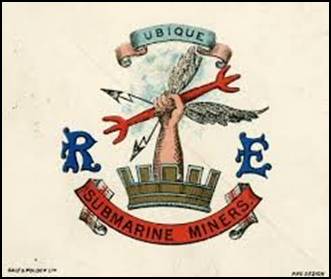
Figure 4. Crest of the Royal
Engineers Submarine Miners.
(Image from a Gale & Polden Christmas Card)
The mission of the 35th Company was to provide an efficient shore based defence for the British naval base at Pembroke Dock. This was accomplished through the use of underwater mines in conjunction with searchlights for harbour defences. The men selected for service with the submarine mining companies had to be physically fit in order to move the heavy mines around and were also chosen for their intelligence and scientific knowledge. After initial training and experience with such mundane tasks as coiling the electric cables used to connect the mines to shore, the men moved on to become divers, electricians, instrument repairers or engine drivers. Sapper Lindsay qualified as a "Skilled" Engine Driver in the 35th Company in September of 1894.[xi] He would have been employed on a submarine mine-laying boat such as the one shown in Figure 5 below. He would be at the Engine Driver position, just in front of the forward mast and just aft of the Number 4 position.
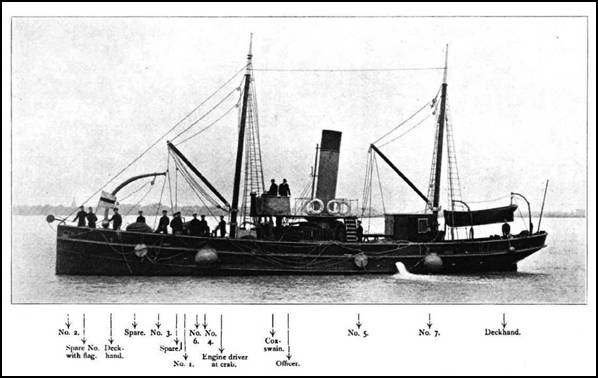
Figure
5. A Submarine Mining Masted Vessel
of the Royal Engineers.
(Photograph from Baker Brown, 1910)
Halifax
and Bermuda (1896-1902)
Sapper Lindsay served with the 35th Company until 14 November 1896 when he departed England for service at Halifax, Nova Scotia. On 5 September 1901 he extended his service again, this time to complete 12 years with the Colours.[xii] Lindsay left Nova Scotia on 31 October 1901 for service on the island of Bermuda.
The 27th Company (Submarine Mining), Royal
Engineers had been at Halifax, Nova Scotia since September of 1886.
In October of 1888 the 27th Company was divided into two
companies, with the 27th Company moving to Bermuda and the newly
formed 40th Company remaining at Halifax.
The 27th Submarine Mining Company combined with half of the 36th
Company at Bermuda to form the 27th (Fortress) Company on the 1st
of July 1905. The 40th
(Submarine Mining) Company was brought home on the withdrawal of the Imperial
Garrison from Canada and was disbanded at Chatham in January of 1906.
It is most likely that Sapper Lindsay served in both of these companies
between 1896 and 1902.
The South African War (Boer War) of 1899 to 1902 was fought during the period that Sapper Lindsay was serving in Canada and Bermuda. Neither the 27th nor the 40th Company was deployed to South Africa to take part in this war; hence, Lindsay did not earn the campaign medals awarded for this conflict.
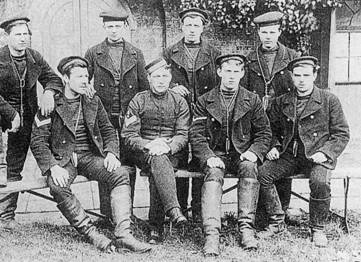
Figure 6. Work Uniforms of
the Submarine Miners, Royal Engineers
(Photograph from Baker Brown, 1910)
Home
Service (1902-1906)
Sapper Lindsay served at Bermuda until 25 March 1902. His service papers are unclear regarding the unit to which he was assigned when he arrived home in England. The Royal Engineers List of December 1905 shows that the 36th (Fortress) Company, R.E. was reconstituted with the 1st Half Company on Bermuda and the 2nd Half Company at Chatham in Kent. Since Sapper Lindsay subsequently left England for service with the 36th Company, R.E. on the west coast of Africa, it may be assumed that he was serving with the 2nd Half Company of the 36th from 1902 to 1906. He may even have served with the 1st Half Company of the 36th on Bermuda prior to returning to England in March of 1902.
On 9 March 1905 Sapper Lindsay re-engaged to complete 21 years of service with the Colours.[xiii]
Sierra Leone (1906-1907)
Lindsay's next posting abroad was to Sierra Leone. He departed the U.K. for Africa on 17 February 1906 and arrived in the British Protectorate of Sierra Leone on 27 February. In Sierra Leone he served with the 36th Company under the command of Captain C.F.B. Pike, R.E.[xiv] Other officers in the company at that time included Lieutenants W.G.S. Dobbie[xv] and J.R.W. Mansfield. In addition to the 36th Company, R.E., the Sierra Leone Fortress Company under the command of Major J.I. Lang-Hyde, C.M.G., R.E. also was stationed in West Africa at Tower Hill in Freetown during this period.
Lindsay
remained in Sierra Leone for a little over one year, departing for home on 4
March 1907 and arriving in the U.K. on 19 March 1907.
His actual service on the west coast of Africa was allowed to count
double towards his pension under Article 1149 of the Pay Warrant of 1906.
The shortness of this tour of duty and the extra credit for serving on
the west coast of Africa were the result of the pestilential living conditions
encountered by Europeans stationed there.
Home
Service (1907-1910)
Sapper Lindsay served at home until 9 September 1910. Again his service papers do not specify the unit to which he was assigned during this period, but he probably was posted to a submarine mining company or fortress company until he departed England for service in Hong Kong with the 40th (Fortress) Company, R.E.
Hong
Kong (1910-1913)
Lindsay served with the 40th Company for more than two years working on the construction and maintenance of fortifications in the port and harbour areas of Hong Kong. He is shown in the 1911 Census of England (Military – China & Hong Kong) as an unmarried 41-year old Sapper (Blacksmith). Of the 29 other men listed on the page in the census, Lindsay is by far the oldest, with ages of the other men ranging from 20 to 29.[xvi]
During Sapper Lindsay's period of service at Hong Kong, the company was commanded by Major St. G.R.S. Caulfeild. Other officers assigned to the company at that time included Captain H.L.G. Bell and Lieutenants B.E. Coke, C.R. Shannon and C.N. Rivers-Moore. Lindsay returned home from Hong Kong on 18 December 1913.
Home
Service (1913-1914)
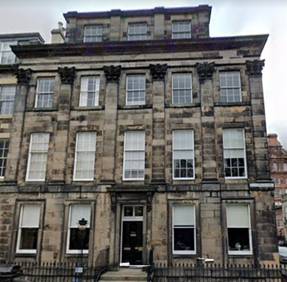
Figure 7. 30 Rutland Square,
Edinburgh.
(Photograph courtesy of Google Earth)
Upon his arrival in the United Kingdom, Lindsay was posted to the Clyde Section of the 49th (Coast Battalion) Company, R.E in the Lowland District of Scotland with headquarters at 30 Rutland Square in Edinburgh.[xvii] This put Lindsay back into the submarine mining business where he had first started out soon after his enlistment in 1893. The Coast Battalion had been formed in 1885 and was part of the Submarine Mining Establishment. It consisted of a body of officers recruited from the warrant and non-commissioned ranks of the Royal Engineers who retained their regimental position and seniority, and were interchangeable with the rest of the Royal Engineers Submarine Miners. The Coast Battalion was divided into sections, one at each commercial port defended by submarine mines. The duties of a section were the custody and maintenance of the submarine mining defence and the instruction of the Volunteer Submarine Miners at the port. At first the Volunteers were raised as companies of existing Volunteer Corps, but later, when they formed into separate divisions, the officer of the Coast Battalion acted as Adjutant of the Volunteer Division in addition to his duties as officer commanding the section.
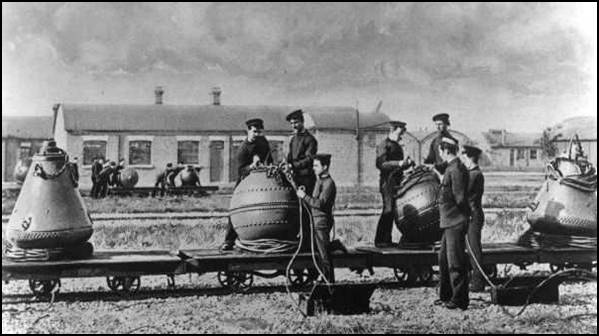
Figure 8. Preparing Mines
for Loading on Boats.
(Photograph from Baker Brown, 1910)
As Lindsay's time in service approached the 21-year mark he expressed his desire to take his discharge upon completion of his second term of limited engagement. On 11 July 1914 Lindsay acknowledged receipt of all pay and allowances due him upon discharge. This acknowledgement was witnessed by Corporal W.G. Slade, R.E. All of his accounts were certified as correctly balanced on 13 July and his discharge was confirmed at Edinburgh on 15 July by the Commander Royal Engineers, Lowland District. Sapper Lindsay was discharged from the Army on the termination of his second period of limited engagement on 27 July 1914.
The following sections are presented in tabular form to summarize Lindsay’s promotions, appointments, military training and qualifications and the medals that he was awarded during his time in the Army. They are provided to give the reader easy access to these aspects of his military career. The tables are followed by sections dealing with his marriage, personal information and post-service life.
6. PROMOTIONS AND CONDUCT
a. Promotions: Sapper Archibald Lindsay did not receive any promotions during his time in service. His conduct appears to have been exemplary during his 21 years of service; however, Lindsay did not attempt to better himself by improving his education. This is apparent from the fact that he earned no Certificates of Education during his service. He appears to have been a proficient engine driver and blacksmith, but was never deemed worthy of promotion to a higher rank.
b. Conduct: Archibald Lindsay received the following Good Conduct Badges during his time in service:[xviii]
Date of Award |
Good
Conduct Badge |
|
28 July 1895 |
Awarded Good Conduct Pay at the rate of 1.d per day. |
|
19 October 1897 |
Forfeited Good Conduct Pay at the rate of 1.d per day.[xix] |
|
19 April 1898 |
Restored Good Conduct Pay at the rate of 1.d per day. |
|
1 April 1900 |
Awarded Good Conduct Pay at the rate of 2.d per day. |
|
27 July 1905 |
Awarded Good Conduct Pay at the rate of 3.d per day. |
|
Unknown |
Awarded Good Conduct Pay at the rate of 4.d per day.[xx] |
NOTE: It appears that he was in Halifax, Nova Scotia on 19 October
1897 when he committed the offense for which he forfeited his Good Conduct Pay.
EDUCATION
AND QUALIFICATIONS
a. Education: As previously stated, Sapper Lindsay did not earn and Certificates of Education during his time in service. This lack of effort or intellectual ability on his part may explain his failure to be promoted to a higher rank during his 21 years of service. As indicated below he was a "superior" engine driver whose skills were considered worthy of additional service pay, yet these qualifications were still not sufficient for him to be promoted above the rank of Sapper. It may be that Lindsay was one of those soldiers who shunned supervisory responsibility. Although his records do not indicate as much, he may have refused promotion being content to remain a Sapper for his entire time in the Army.
b. Qualifications: Sapper Lindsay earned the following qualifications during his time in service:
Date |
Qualification |
|
24 September 1894 |
Passed the class of instruction in Engine Driving ("Skilled"). Qualification approved by the Commander Royal Engineers, Western District. |
|
18 June 1895 |
Passed the class of instruction in Engine Driving ("Superior"). Qualification approved by a Staff Officer, Royal Engineers, Western District. |
|
April 1902 |
Granted service pay at the rate of 7.d per day in the rank of Sapper in accordance with Army Order 66 of 1902.[xxi] |
|
14 June 1911 |
Qualified in swimming. |
Sapper Lindsay qualified for the award of the Army Long Service and
Good Conduct Medal on 27 July 1911 after completing 18 years of service.
He was awarded the medal with a gratuity of £5 by Army Order 92 of 1911.[xxii]

Figure 9. The Army Long
Service and Good Conduct Medal (Edward VIIR)
Awarded to Sapper Lindsay.
(Photograph from the author’s collection)
The medal is named to Lindsay in impressed upper case lettering as
follows:
27557
SAPR A. LINDSAY. R.E.
9. MEDICAL INFORMATION
Sapper Lindsay's military records did not contain a Medical History Sheet.
10. MARRIAGE AND PERSONAL
INFORMATION
According to his military service papers Archibald Lindsay was not
married prior to or during his time in service.
No information regarding his marriage was located on any family trees
posted on Ancestry.com, nor were any records of his marriage to anyone located
in any official documents in the England, Scotland, Wales or Canada.
11. DISCHARGE
Sapper Lindsay was discharged from the Army at Greenock, Renfrewshire, Scotland on 27 July 1914 on the termination of his second period of limited engagement. His total service was reckoned as shown in the tables below:
Location |
Period
of Service |
|
Home |
28 July 1893 to 13 November 1896 |
|
Halifax, Nova Scotia |
14 November 1896 to 30 October 1901 |
|
Bermuda |
31 October 1901 to 24 March 1902 |
|
Home |
25 March 1902 to 16 February 1906 |
|
Sierra Leone |
17 February 1906 to 18 March 1907 |
|
Home |
19 March 1907 to 8 September 1910 |
|
Hong Kong |
9 September 1910 to 17 December 1913 |
|
Home |
18 December 1913 to 27 July 1914 |
Location |
Period
of Service |
|
Home Service |
11 years and 73 days |
|
Service Abroad |
9 years and 292 days |
Total Service (actual)
|
21 years exactly |
Total Service (for
pension)
|
22 years and 6 days[xxiii] |
Sapper Lindsay's discharge papers indicate that he was a blacksmith by trade. This was his civil trade prior to entering the Army and appears to have been the trade he worked at while in the service. He was also an engine driver in the Army, meaning that he could operate oil and steam engines used during his time in the submarine mining companies.
Lindsay's
military character was described as "Exemplary" and his commanding
officer indicated that he was "a very steady, reliable and hardworking
blacksmith.” [He was] “capable
of taking charge of oil and steam engines and making minor repairs [and he
could] “be trusted to complete
work without supervision." At
the time of his discharge, Lindsay was entitled to Class II Proficiency Pay and
the lowest rate of 7.d per day. With
the glowing terms used by his commanding officer to describe his military
character, it is hard to understand why he never was promoted above the rank of
Sapper. If his performance of duty
was “Exemplary” one must assume that his conduct was not.
12. POST SERVICE LIFE
Sapper Lindsay indicated that upon discharge his intended place of residence would be 19 Bruce Street in Greenock, Renfrewshire.[xxiv] This had been his family’s home from the date of his enlistment in the Army. Other than his intended place of residence, no further information is known regarding his post service life.
Lindsay was discharged within a week of the outbreak of the Great War of 1914-1918. No evidence could be found to indicate that he was called back to serve in that war; hence, it is believed that he saw no active service during his military career.[xxv] As previously indicated, the Army Long Service and Good Conduct Medal in the author's collection is Sapper Lindsay's only medal entitlement.
REFERENCES
Books
1. BAKER BROWN, W.
The History of the Corps of Royal
Engineers. Volume IV.
The Institution of Royal Engineers, Chatham, Kent, 1952.
2. BAKER BROWN, W.
History of Submarine Mining in the
British Army. W. & J. Mackay
& Co., Ltd., Chatham, 1910.
3. CHICHESTER, H.M. & BURGES-SHORT, G.
The Records and Badges of Every
Regiment and Corps in the British Army.
Gale & Polden, Ltd., London, 1900.
4. CONOLLY, T.W.J. Roll
of Officers of the Corps of Royal Engineers From 1660 to 1898.
The Royal Engineers Institute, Chatham, Kent, 1898.
5. GRIERSON, J.M.
Scarlet Into Khaki: The British
Army on the Eve of the Boer War. Greenhill
Books, London, 1988.
6. SKELLEY, A.R.
The Victorian Army at Home: The
Recruitment and Terms and Conditions of the British Regular, 1859-1899.
McGill-Queen’s University Press, Montreal, 1977.
Soldiers Died in the Great War.
The Naval & Military Press Ltd., Heathfield, East Sussex, 1998.
Documents
LARIMORE, F.B. Long Service and Good Conduct Chevrons (Badges) and their Periods of Qualification. Drexel Hill, Pennsylvania, 1998.
Family Tree
Archibald Lindsay (trann120)
https://www.ancestry.com/family-tree/person/tree/155368790/person/202049144516/facts
Periodicals
1. The Monthly Army List, June
1890.
2. The Royal Engineers Monthly
Lists, 1905.
3. The Royal Engineers Monthly
Lists, 1908.
Soldier's Service Papers (WO364/2100)
1.
Short Service Attestation (Army Form B. 217), consisting of the
following sections:
a. Questions to be put to the Recruit before Enlistment.
b. Oath to be taken by the Recruit on Attestation.
c. Certificate of Magistrate or Attesting Officer.
d. Description on Enlistment.
e. Certificate of Medical Examination.
f. Certificate of Primary Military Examination.
g. Certificate of Approving Field Officer.
h. Military History Sheet.
i.
Statement of Services.
2. Proceedings on Discharge (Army Form B. 268).
[i] National Archives research performed by Mr. Stuart Gase of West Drayton, Middlesex.
[ii] Greenock is a busy port and manufacturing town on the River Clyde Estuary, with many shipbuilding yards and docks. Greenock is located about 20 miles west northwest of Glasgow.
[iii] Ragged schools were charitable organizations dedicated to the free education of destitute children in 19th century Britain. The schools were developed in working-class districts. Ragged schools were intended for society's most destitute children. Such children, it was argued, were often excluded from Sunday School education because of their unkempt appearance and often challenging behaviour.
[v]
CHICHESTER & BURGES-SHORT, p. 824.
[vi]
See Age and
Physical Requirements for Soldiers in the British Army and the Corps of
Royal Engineers (Victorian Period).
[viii] Later Colonel. Took part in the Sudan Campaign, 1884-1885.
[x] Later Major. Service in South Africa, 1900-1901.
[xi] The 35th Company became an experimental submarine mining company in May of 1892 and was active in this role when Sapper Lindsay joined it.
[xiv] Later, Major.
[xv]
Later Lieutenant General Sir William
George Shedden Dobbie, GCMG, KCB, DSO
(12 July 1879 – 3 October 1964) was a British Army veteran of the Second
Boer War and the First and Second World Wars.
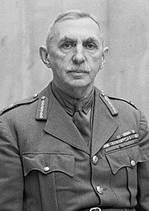
Figure
10. Lieutenant General Sir
William George Dobbie, GCMG, KCB, DSO.
(Photograph courtesy of Wikipedia)
[xvi] He obviously was lagging far behind his contemporaries with regard to promotion, due perhaps to his efficiency as a soldier or his conduct.
[xvii] The 49th Company had sections at Forth, Clyde and Tay.
[xix] The reason for this forfeiture of Good Conduct Pay is not stated in Lindsay's service papers.
[xx] Lindsay's service papers indicate that he was in possession of four Good Conduct Badges at the time of his discharge from the Army; however, his Statement of Services does not indicate the date of the last award.
[xxi] Service Pay in addition to their regular pay, was granted to men in the Royal Engineers who demonstrated proficiency in their military trades. Service or Proficiency Pay was awarded in seven classes, with Class I being the highest. Lindsay eventually qualified for Class II Proficiency Pay by the time of his discharge in 1914.
[xxii] This medal is in the author's collection and is the reason for this research work.
[xxiii] The additional year and 6 days for pension purposes is due to his time in Sierra Leone being counted as double.
[xxiv] Bruce Street is only one block long and that block currently is occupied by a restaurant and bar known as the Argyll & Sutherland.
[xxv] A search was made in Soldiers Died in the Great War. Four men by the name of Lindsay were casualties during the war while serving in the Royal Engineers, but Archibald Lindsay was not among them.